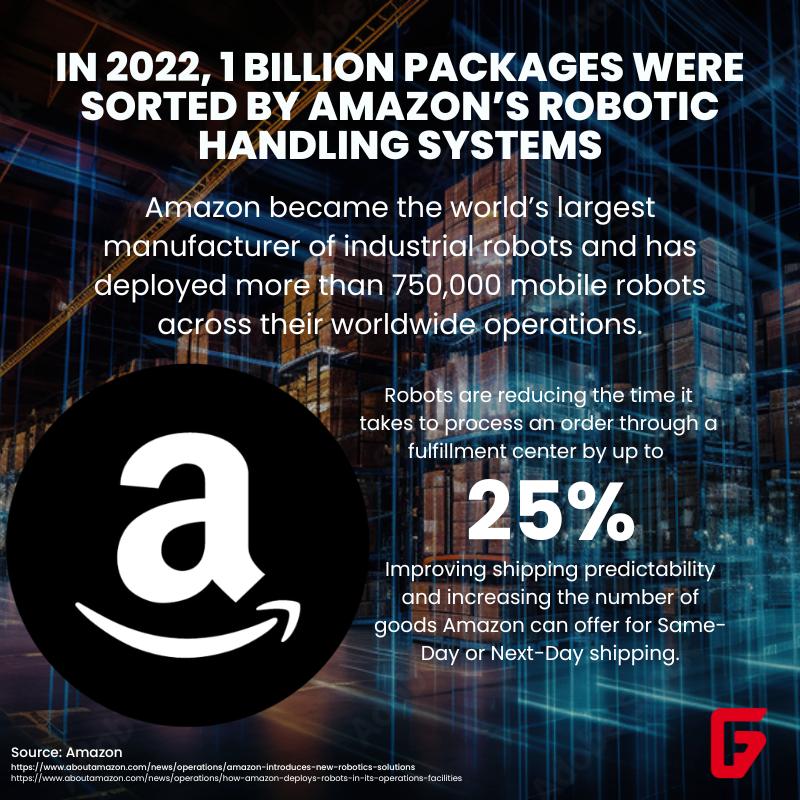
By futureTEKnow | Editorial Team
Amazon is always making waves in the world of industrial robotics as they did last year with the introduction of Sparrow and Cardinal, two groundbreaking robotic systems designed to transform the way items are handled within their vast warehousing operations. These remarkable robots represent a significant leap forward in the state-of-the-art technology of industrial robotics, revolutionizing the way Amazon manages its extensive inventory and optimizes the shipping process.

Sparrow is a robot with precision handling at scale and became a true trailblazer in Amazon’s warehouses, is the very first robotic system capable of detecting, selecting, and handling individual products from the vast inventory. Its capabilities are made possible through a fusion of cutting-edge computer vision and artificial intelligence (AI). With Sparrow, Amazon can efficiently and accurately recognize and handle millions of unique items.
Cardinal is the smart package selection and sorting robot. This robotic workcell leverages advanced artificial intelligence and computer vision to accomplish a remarkable feat—swiftly selecting one package from a pile, lifting it, reading its label, and precisely placing it in a GoCart, ready to continue its journey through the shipping process. Cardinal’s streamlines the entire operation, resulting in faster processing times within the facility.

The seamless collaboration between these integrated robotic systems significantly optimizes inventory management, making it not only more efficient but also safer for employees. This collaboration has yielded impressive results, with Amazon’s data showing that robotics sites experienced 15% lower recordable incident rates and 18% lower lost-time incident rates in 2022 compared to non-robotics sites.
In a move that highlights their commitment to streamlining operations and ensuring the safety of their workforce, Amazon has introduced two innovative robotic systems, Sequoia and Digit. These cutting-edge solutions are set to transform how Amazon fulfills customer orders and improve the work environment for its employees.
Sequoia, the latest addition to Amazon’s robotic fleet, has been strategically deployed at a fulfillment center in Houston, Texas, just in time to accommodate the surge in holiday orders. This remarkable technology is poised to enhance the accuracy of delivery estimates, expedite order processing, and bolster the safety of Amazon’s workforce.
The key to Sequoia’s success lies in its ability to expedite the identification and storage of inventory by up to 75% compared to current methods. This accelerated process translates into quicker listings on Amazon.com, benefiting both sellers and customers. Furthermore, Sequoia optimizes the order processing time by up to 25%, resulting in improved shipping predictability and an increased number of goods eligible for Same-Day or Next-Day shipping.
Sequoia employs a multifaceted approach to containerize inventory into totes. It integrates mobile robots, gantry systems, robotic arms, and ergonomic employee workstations. Mobile robots transport containerized inventory to a gantry, where the items are either restocked in totes or sent to employees who pick inventory for customer orders. The ergonomic workstation design allows employees to work within their power zone, reducing the risk of injuries that might arise from constant reaching and squatting.
Amazon is expanding its automation initiatives with Digit, the bipedal robot developed by Agility Robotics. This cutting-edge robot is designed to move, grasp, and handle items, making it ideally suited for navigating spaces and corners within Amazon’s warehouses.
Digit’s size and shape are well-matched to human-designed environments, offering significant potential for scaling up the use of mobile manipulator solutions like Digit in collaborative work with employees. In the initial stages, Digit will be employed to assist employees in tote recycling, a highly repetitive process involving the picking up and moving of empty totes once they’ve been emptied of inventory.
Amazon is dedicated to ensuring that its robotics systems are designed to collaborate with employees and enhance their work experience. Over the past decade, Amazon has introduced hundreds of thousands of robotics systems while simultaneously creating hundreds of thousands of new job opportunities within its operations. This expansion encompasses a staggering 700 categories of new job types, particularly in skilled roles that did not exist within the company prior to these technological advancements.
By equipping their employees with cutting-edge technology and providing training to develop new skills, Amazon is paving the way for career growth and exciting opportunities for its workforce. Amazon’s commitment to both innovation and employee well-being ensures that these latest robotic solutions will continue to make a significant impact on the company’s operations and the overall e-commerce landscape.
Founded in 2018, futureTEKnow is a global database dedicated to capturing the world’s most innovative companies utilizing emerging technologies across five key sectors: Artificial Intelligence (AI), immersive technologies (MR, AR, VR), blockchain, robotics, and the space industry. Initially launched as a social media platform to share technology news, futureTEKnow quickly evolved into a comprehensive resource hub, spotlighting the latest advancements and groundbreaking startups shaping the future of tech.

Bridgit Mendler’s Northwood Space is pioneering mass-produced ground stations, enabling scalable, high-speed connectivity for the new era of satellite networks and megaconstellations.

SpaceX aims to nearly double launches from Vandenberg in 2025, facing support from federal agencies but strong objections from the state and local communities.

Traditional Medicare will pilot AI-assisted prior authorization in 2026 across six states, focusing on high-risk outpatient services. Clinicians retain final say, but incentives and access concerns loom as CMS tests fraud reduction and “gold card” exemptions. Here’s what providers and patients should know.

OpenArt’s new “one-click story” compresses scripting, visuals, and edits into ready-to-post short videos—fueling viral growth and a fresh IP debate. We break down how it works, adoption signals, what’s next (multi-character, mobile), and practical guardrails creators and brands should follow to stay original and compliant.

OpenAI’s o3 swept the Kaggle AI chess tournament, defeating xAI’s Grok 4–0. The victory fueled the intense rivalry between Altman and Musk, reshaping AI benchmarks.

NASA and Google’s AI-powered Crew Medical Officer Digital Assistant enables autonomous diagnoses for astronauts on Mars missions, redefining remote healthcare for space and Earth.

Pinterest’s CEO confirms that fully agentic AI shopping is years away, as the platform invests in AI-powered tools to enhance discovery, inspiration, and personalized shopping experiences for millions.

Shopify’s new AI shopping tools are transforming e-commerce, letting agents and chatbots deliver smooth, personalized shopping and checkout experiences across platforms. Learn how these innovations reshape online retail.

Meta has acquired WaveForms AI, a startup pioneering emotion-detecting voice technology. Learn what this means for Meta’s AI voice ambitions and the future of AI audio.

Tracelight is revolutionizing financial modelling for finance professionals with AI-powered Excel tools that automate complex tasks, reduce errors, and unlock new analysis capabilities. Learn how this next-gen solution changes the future of spreadsheets.

China’s Lanyue lander completed its first major test, showcasing advanced engineering for safe, crewed moon landings before 2030. Explore how this milestone shapes the space race.

Microsoft rolls out GPT-5 across its Copilot suite, integrating smarter AI for enterprise and personal users. Discover new features, free access, and what sets this launch apart.
To provide the best experiences, we use technologies like cookies to store and/or access device information. Consenting to these technologies will allow us to process data such as browsing behavior or unique IDs on this site. Thanks for visiting futureTEKnow.